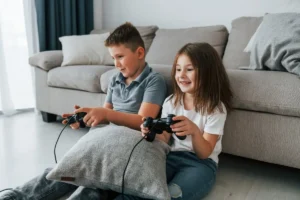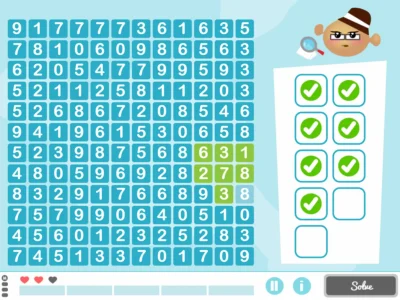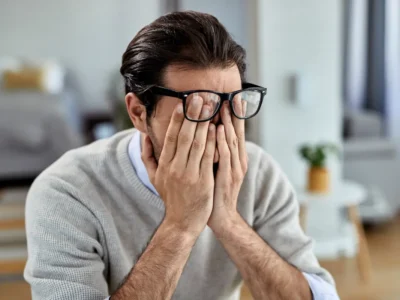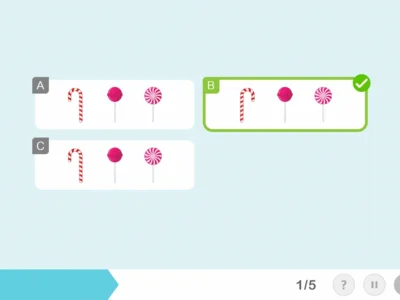Dr. Pablo Barrecheguren, PhD in Biomedicine, explains to us the power of video games to alleviate neurological problems: the pioneering example against lazy eye.
Currently, one of the most powerful industries in the world is video games, with a large portion of the population consuming these kinds of products (for example, 42% of the Spanish population) and this industry worldwide represented a market of $108.9 billion in 2017. Given the size of this industry, many researchers have asked whether it is possible to use video games for therapeutic purposes, and one of the best-documented cases are studies on amblyopia.
The problems of the lazy eye
Amblyopia, commonly known as lazy eye, is one of the most common childhood vision problems, with an approximate prevalence of 2.4% of the population, which means it affects about 15 million children worldwide.
This problem has a neurological origin, since “the lazy eye” is structurally normal, but at the level of the nervous system that controls the eyes there is an imbalance that favors the use of one eye over the other.
This results in vision problems, as well as a negative impact on quality of life by making reading more difficult, hindering the development of motor skills and it can even decrease children’s self-esteem by affecting their self-image.
Patch treatment
Although this problem has been known for years, the main treatment has hardly changed in recent decades: it involves covering the healthy eye with a patch to force the activity of the lazy eye.
The underlying idea is that by forcing the use of the lazy eye, all its neural connections will strengthen to the point that the neurological imbalance between both eyes disappears.
This is highly dependent on the patient’s age, since the older the age, the lower the brain plasticity, with an average of 170 hours with the patch needed for a four-year-old patient, about 236 hours to achieve a similar effect in a six-year-old patient and if the child is older than seven years the treatment period with the patch exceeds 400 hours.
To this massive volume of hours must be added the discomfort and loss of vision the child suffers during treatment, as well as the fact that, since these are neuroplastic processes, the improvement may reverse once the treatment ends (up to 25% of patients experience a regression in their first year of treatment).
Video games to improve visual perception
In this context, there is a growing scientific literature detailing that in adults the consumption of certain types of video games can improve various aspects of visual perception. Specifically, first-person action games (such as the Call of Duty series, Battlefield or the popular eSport Overwatch) seem to have this effect, while in other genres such as simulation video games or games like Tetris these effects have not been detected.
The idea of using video games as therapy to reorganize the connections of the visual nervous system has great potential, since video games are a very attractive product for children and one of the problems faced by amblyopia treatment is its duration and that it is extremely uncomfortable, which limits patient compliance and this could be solved with a gamified treatment.
Furthermore, if video games are an efficient approach, it is possible that the hundreds of hours of current treatment may not be necessary to cure amblyopia.
Study with The Magical Garden
In a recent study, twenty-one patients with unilateral amblyopia were asked to play a total of twenty hours of The Magical Garden, a first-person video game created with the game engine of the popular first-person action game Unreal Tournament, but removing all violent content from the original.
Players only had to move around the environment, collect objects, and mark movable objects such as robots that appeared on the screen with the pointer. The results of the experiment were an improvement in the patients’ visual capabilities that largely persisted 6-10 weeks after the procedure.
Thus opening the way to a potential therapeutic use of video games to treat neurological problems.
Bibliography
- Fronius, M., Cirina, L., Ackermann, H., Kohnen, T., & Diehl, C. M. (2014). Efficiency of electronically monitored amblyopia treatment between 5 and 16 years of age: New insight into declining susceptibility of the visual system. Vision Research, 103,11–19.
- Gambacorta, C., Nahum, M., Vedamurthy, I., Bayliss, J., Jordan, J., Bavelier, D., & Levi, D. M. (2018). An action video game for the treatment of amblyopia in children: A feasibility study. Vision Research, 148 (March 2018), 1–14.
- Green, C. S., Li, R., & Bavelier, D. (2010). Perceptual learning during action video games. TopicS. Special Issue on Perceptual Learning, 2(2), 202–216.
- Lee, H. J., Tran, D. D., & Morrell, H. E. R. (2018). Smoking, ADHD, and Problematic Video Game Use: A Structural Modeling Approach. Cyberpsychology, Behavior, and Social Networking, 21(5), 281–286.
- Tetik, B. K., Kayhan, D., Sertkaya, S., & Sandikci, K. B. (2018). Evaluation of the effects of digital play addiction on eating attitudes. Pakistan Journal of Medical Sciences, 34(2), 482–486.
- Wu, C., & Hunter, D. G. (2006). Amblyopia: Diagnostic and therapeutic options. American Journal of Ophthalmology, 141(1), 175–184.
If you liked this article about Video Games against Neurological Problems, you may also be interested in the following articles:
“This article has been translated. Link to the original article in Spanish:”
Videojuegos contra problemas neurológicos: el ejemplo pionero contra el ojo vago







 Brainbow: How to color a brain
Brainbow: How to color a brain
Leave a Reply